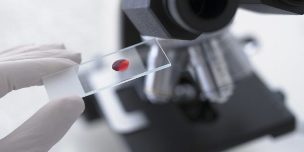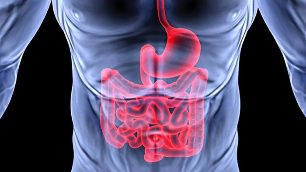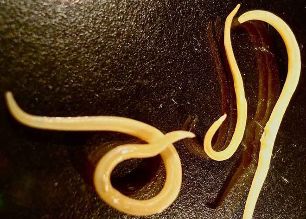Before you start the treatment of parasites, it is important to accurately determine which species is present in the body. It is necessary to find effective methods of treatment, as most medications developed specifically to get rid of a specific species of worms. The main methods of diagnosis that allows to identify the pathogen invasion:

- analysis of stool;
- analysis of blood: total, as well as immunoassay;
- swab;
- analysis of the secrets of the 12 duodenal ulcer;
- tomography;
- Ultrasound.
Parasites can be detected with a blood test. After a single negative result, the majority of tests need be repeated. It is necessary to obtain an accurate result. If the results of the tests confirmed the presence of worm infestation, it is important to immediately start treatment against worms. It involves 3 successive stages:
- Preparation of the body – the use of sorbents, pumpkin seed oil, which intensifies the process of removing accumulated toxins. It lasts 5-7 days.
- The use of anthelmintic drugs can be the drops or suspension are designed to kill certain types of parasites:
- From nematodes to help preparations of wide action;
- The recovery phase helps to restore the normal functioning of the body, the immune system. It involves the use of sorbents, vitamin complexes, and in some cases appointed by other medications.
Treatment of helminthiasis should be under the supervision of a physician. When it comes to the infestation of tapeworms and flukes, shows the treatment in hospital. Pharmacological medical drugs are very toxic. After their use there are severe side effects, and it is strictly prohibited for pregnant women. In this regard, many prefer to get rid of the worms with the help of medicine. In its Arsenal there are many recipes, which have been effective for centuries. Pronounced effect against worms has a large number of herbs and plants: pumpkin, tansy, wormwood, immortelle, flax, onions, garlic, nuts, pomegranate, carrots. On their basis prepare decoctions, infusions. They are assigned for oral or cleansing enemas. The latter are intended to combat helminth parasites in the intestine. When choosing a method of treatment please note that the recipe did not contain botanicals, which you are allergic. To minimize the risk of helminth infection, it is important to comply with preventive measures:
- wash hands before eating, and after visiting the toilet, touching animals;
- thoroughly washed and scalded fruits, vegetables, greens;
- subjected to sufficient heat processing of meat, fish;
- to conduct deworming of Pets.
To prevent parasites, always wash your hands thoroughly. At the first symptoms of helminthiasis, even if you feel that you could not get infected with worms, you should go to the doctor. He will assign a diagnosis, if necessary, will pick up the funds for treatment against worms.
Simple worms
Sometimes you can hear the phrase that the patient infections protozoa worms. You need to understand that protozoa – single-celled organisms, at least those who organize the colony. Ale stink never many cell like worms and worms. The simplest of all the processes occur within the cell cytoplasm and cell nuclei, in one hour as the worms anatomical organization is much more difficult: they have different bodies that perform special physiological functions. Therefore, enter the worms, to simple wrong. Sometimes called helminths protozoan parasites in comparison to insects: bedbugs, lice etc. as the last to stand much higher on the evolutionary ladder. In this sense, the name of worms protozoa allowed.
The most common parasites
The most common endoparasites in are, of course, helminths (worms), which, according to various estimates, infected more than 80% of the world population. A huge number of these parasites are divided into basic types:
- nematodes – round worms (roundworm, pinworm, Trichinella in, whipworm, etc.);
- cestodes – tapeworms (lantecy, pork and beef tapeworm, tapeworm, etc.);
- flukes are worms flukes (liver, blood, Jan, lung, and flukes that live in the intestines).
Sometimes you can find a more General classification, according to which all types of parasites people are divided into:
- intestinal, parasites in the intestine;
- tissue, localized in other organs and tissues.

Razglyadev brief description of the most common types of worms.
Roundworms (nematodes)
- Roundworm – roundworms are the most common length from 20 to 40 cm, parasites in the small intestine, but first migrate in the human body, affecting the blood and respiratory system. Along with these intestinal parasites can be detected in the liver and gall bladder, heart and lungs. A common symptom of ascariasis and allergic reaction.
- Pinworms – small worms, up to 1 cm, which affects the intestine and result in enterobiasis with disorder of the digestive tract, exhaustion, sleep disorders, etc Characteristic symptom of pinworms is itching in the anus, where they lay their eggs.
- Trichinella in these microscopic worms (their size only a few millimeters) lead to severe diseases – trichinosis, which can if untreated can lead to death. Adults ViDi live in humans in the muscles (respiratory, personal, etc.), causing m Azov pain, fever, swelling, allergic skin rash.
- Vlasoglavy – worms small (length up to 4.5 cm, with the front part of the body in the form of threads), larvae of which cause trihozefalez with diarrhea, acute abdominal pain and other symptoms resembling appendicitis. As a result of intoxication anemia.
Tapeworms (cestodes)
- A tapeworm, body length which can reach up to 10 m, leads to the development of difillobotrioz with nausea, weakness, vomiting, unstable chair, asthenia and anemia.
- Pork tapeworm has a length of from 3 to 8 m, a parasite mainly in the small intestine and causes two diseases: taeniasis with dyspeptic, asthenic-neurotic and abdominal syndromes, and cysticercosis with ebrietas, intestinal, allergic and respiratory symptoms. Depending on the localization of tsistitserki affects soft muscles, brain, heart, eyes and so on.
- Beef tapeworm whose length may reach 18 m, and causes the beef tapeworm infection is considered to be one of the most dangerous types of worms. If you do not do deworming, it can stay in the body for up to 18-20 years! Is localized in the large intestine, causes severe intoxication with their waste products, as well as diarrhea, nausea, vomiting, abdominal pain, anemia, allergic reactions and problems with the nervous system.
- Dwarf tapeworm length 1.5-5 cm source gimenolepidoz with dyspeptic pain and astheno-neurotic syndrome affecting primarily the digestive and nervous system, and liver.
- Echinococcus is considered to be the smallest tape worm – its length is from 2.5 to 8, rarely 9 mm, but the infection it has terrible consequences such as liver and lung, where they form cysts and tumors causing dysfunction of these organs.
Worms are flukes (trematodes)
- Liver flukes, or the liver Fluke is shaped like a sheet with a length of 30-50 mm and a width of 8-13 mm, has a suction Cup. It damages the sheath of the liver and clog the bile ducts that is able to completely block the flow of bile. Can lead to cirrhosis, jaundice and liver cancer.
- Cat (Siberian) flukes, or cat Fluke, a flat worm with a length of 4-13 mm. Localization – the ducts of the gallbladder, liver and pancreas. Causes opisthorchiasis with the development of gastritis, ulcers, pancreatitis, cholecystitis until liver cancer, which can lead to death.
- Lung flukes has an ovoid shape, red-brown body with small spines, length from 7.5 to 12 mm with a width of 4-8 mm Affects the lungs, causing inflammation, pleural effusion, focal fibrosis, and lung cancer. When the penetration into the brain causing encephalitis and meningoencephalitis.
- Shistosoma (Jan blood flukes) – dioecious worms with a size of 1-2 cm, the eggs of which cause an increase in liver, spleen and lymph nodes, the formation of polyps in the intestine, diarrhea, granulomatous inflammation, leading to cancer of the bladder.
Protozoan parasites
Toxoplasma gondii (Toxoplazma gondii) is a species of parasite, the primary host are cats. Can also be transported by warm-blooded animals and humans. Disease caused by per Toxoplasma is called toxoplasmosis. The disease is easy, with the exception of injury of the fetus inside the mother's womb during pregnancy, which poses serious consequences for both the mother and fetus, even in death.
Amoeba is the simplest unicellular organism, which is considered to be one of the first creatures that lived on Earth. The disease caused by the amoeba, is called amebiasis. Intestinal infection with a primary ulcerative lesion of the colon with the appearance of blood anisto diarrhea, possible formation of secondary foci of intestinal, has a tendency to chronic course. Malaria parasites – a simple one cell creature, in the development cycle of which the person is a temporary owner, and the mosquito – permanent. In the human parasite Plasmodium is presented in 4 types:
- P. malarie – the four malaria;
- P. vivax — falciparum malaria;
- P. ovale — ovale three-day malaria;
- P. falciparum — tropical malaria;
The length of the interval between bursts depends on the type of pathogen. Besides all this anemia, because the parasite affects the blood of the bullock, Joanna erythrocytes. The disease can occur in mild or severe form.
Pathways in the body:
- water through the dirty water;
- contact – household – when using items, clothing, utensils;
- alimentary – through the dirty vegetables, fruits, foods that have not undergone heat treatment.
Sometimes it so happens that the media parasites not sick, and only a carrier and identifies the pathogen in the external environment. The development of the disease it is enough to enter the human body only a few Giardia cysts. Leishmania – representatives of this genus cause leishmaniasis. The vectors are mosquitoes. The main contingent of the lesion there are people, rodents, mammals. For the full development of the pathogenic organism requires two hosts. This mosquito and a vertebrate representative. Human disease caused by Leishmania invasion:
- visceral leishmaniasis (that dum-Dum) – there is a lesion of the internal organs;
- skin leishmaniasis (Baghdad ulcers) – skin lesions, often of the head, with subsequent scarring;
- leishmaniasis of the skin and mucous membranes is manifested severe destructive lesions of skin and mucous membranes
- Prevention consists of rehabilitation centers for the breeding of mosquitoes, rodents, control over the number of dogs, the burial of dead animals.
Trichomonas – flagellated single-celled organisms, pear-shaped, causing the disease trichomoniasis, which are sexually transmitted and affect the genitourinary system. It is noteworthy that the sick men and women, but in men, the disease is usually asymptomatic. Trypanosoma is a genus of unicellular flagellate protists. Cause severe disease trypanosomiasis, a deadly for the person is sleeping sickness. A carrier of trypanosome have bedbugs, tsetse flies. In the host's body the parasite multiplies under the skin and then enters the lymphatic system and the roof. The majority of pathogens is located in the spinal cord and brain, where it destroys cells and secrete their toxins.
Flat worms
Flat worms, or flukes (trematodes), which have a characteristic leaf shape of the body. Their structure is very well organized — they have a digestive, excretory and nervous system. During the life cycle of their owners. Widely used such kinds:
- Siberian Fluke (cat Fluke), or opisthorchis. The most common infection is through raw fish, which leads to quite a dangerous disease opisthorchiasis. Reproduction of the parasites occurs very quickly, which can cause serious consequences. Worms are yellowish, and their length can exceed 12 m. Anchored in the human body, these parasites provoke internal bleeding, impaired bile flow, causing dysfunction of the pancreas. Dangerous effects: cholangitis suppurative type, ahilii, cholangiocarcinoma.
- Liver Fluke. Intermediate host are the representatives of the cattle, and man becomes infected by eating poorly processed meat of affected animals. As a result of infection develops the disease fascioliasis. The size of these worms is relatively small (not more than 5-6 cm), ale stink, can provoke dangerous disease: hepatic abscesses, cholangitis, hepatitis. Through the roof of the larvae of the parasite can spread throughout the body.
- Shistosoma. The worm can reside in the blood vessels, consuming the blood of Yana components. As a result, his life may develop varicose veins, tumors. The main symptom — an intense General intoxication.
Beef tapeworm
Beef tapeworm can reach a length of 12 m. It is a hermaphrodite that can produce more than 100,000 eggs, they are excreted in the feces. The eggs get into the soil, then into plants, these plants eats cattle. In the animal body, the eggs become larvae, which are localized in the muscles. If a person eats infected beef, the larvae enter the intestine. Human-to-human larvae are not transmitted.
Adult worms have a head with four suckers, neck and body, consisting of segments. The number of segments is constantly growing, Mature segments can be separated from the worm to crawl out of the man's intestines out.
Beef tapeworm: symptoms
Symptoms are nausea, vomiting, dyspepsia, increased salivation, dizziness, weakness, nervousness, fatigue, abdominal pain of uncertain localization, allergies, fluctuations in appetite.
In order to bring the beef tapeworm from the body is consisting of 3 stages: preparation (cleansing), treatment with antiparasitic drugs, recovery (diet, herbal medicine).
Tape worms

The worms ribbon-type, or cestodes, are various flat worms, the length of which can range from 2 mm to 10-12 m. the Body of these parasites has a specific structure — multiple segments, neck and head with suction cups (with hooks) for attaching to the wall. The cestode is a hermaphrodite and the eggs are in the segments. Nutrients the worm sucks through the entire surface of the body.
Tapeworms
There are common types of tapeworms:
- Alveolar. Its activity determines the occurrence of the extremely dangerous disease alveococcosis. Individuals can have a length of more than 4 m. a Feature of these worms is the formation on the dock of dense knots of a whitish shade with a diameter greater than 2 cm, which resemble a malignant tumor. The most typical localization is the lungs, kidneys and liver. May cause cholangitis and abscess, but also spread to spleen, soft muscles and the brain.
- Cepni, or tapeworms. Widespread varieties such as bovine and pork tapeworm, broad tapeworm. They are large in size — more than 10 m, and a large life expectancy — more than 20 years. Beef tapeworm excites disease beef tapeworm infection, and is usually in the small intestine. Serious complications — cholecystitis, intestinal obstruction, appendicitis. Pork tapeworm is a little smaller than their "brothers" (length 2-3 m). It becomes the cause of teniasis. A tapeworm is manifested in such disorders as difillobotrioz. Infection it occurs through poorly cooked fish. This worm is able to lead to such consequences: atrophy of the intestinal sheath, Gunter glossitis, leukopenia.
The diseases that they cause
The most dangerous parasites living in the human body, can cause various diseases. Very often, the disease provoked by a particular parasite to carry the same name as him. Thus, various types of parasites in humans can cause the following diseases:
- certain parasites in man (flukes) trematode provoke;
- the cestodosis occur when you lose tapeworms;
- if an adult or child in the intestines are the round worms, nematodes that diagnose;
- Pierre turnout cause hirudins;
- Arctocephalus provoke skrebni.
However, the parasites on the human body can not hit one body.

- Affections of the eye;
- Diseases of the gastrointestinal tract that cause single-celled parasites and helminths – ascariasis, trichinosis, hookworm, enterobiasis;
- Brain diseases – echinococcosis, toxoplasmosis
- Dermatological disease – demodicosis, pediculosis, scabies;
- Lung pathology – hydatid disease, ascariasis, etc.;
- The liver disease opisthorchiasis, echinococcosis;
- In the mouth, the ears and mouth parasites can cause various types of disease;
- Pathology of the heart;
- Diseases of the genitourinary system;
- Pathology of blood vessels.
Drugs for the treatment of parasitoses
At present there are a number of drugs for the treatment of parasitosis. For the treatment of helminth infections using drugs broad-spectrum and narrow spectrum of action. In addition to these drugs, we recommend taking vitamins, drugs to restore the microflora of the intestine. Contribute to the restoration of microflora and fermented milk products bacterial, but not fungal yeast. To prevent strong allergic reactions use antihistamines, glucocorticoids. Recovery process of digestion is sometimes advisable to take Thrawn enzymes, choleretic drugs. In the treatment of helminthiasis should be aware that modern drugs significantly reduce the ability of worms to resist the digestive enzymes of the body, so find dead worms in the stool is not always possible.
Folk remedies
- Papaya: papaya seeds are very useful for the treatment and removal of intestinal worms. They present caricin, which is effective for killing roundworms. Add one teaspoon of seed powder in a glass of water or milk and drink on an empty stomach in the morning daily.
- Garlic is very useful for home treatment of intestinal worms. Eat three cloves of garlic every morning for best results.
- Carrots are very useful for getting rid of tapeworms. Enough to take in the morning on an empty stomach a few spoonfuls of grated carrots.
- Pumpkin: take approximately one tablespoon of pumpkin seeds, peel off the transparent husk, chop and put in 250 ml of boiling water to make an infusion. And then drink it to expel worms from the intestines
- Pomegranate: the bark, roots and stems of pomegranate are very effective in killing worms
The most effective is the pomegranate peel. A cold decoction of the bark in a dose of 90 to 180 ml you need to drink three times a day, at intervals of one hour.
- Turmeric: dry powder or juice of turmeric mixed with oil, milk or water is very useful not just for deworming, but also in problems with the intestines, especially chronic diarrhoea.
- Tincture of birch leaves in brandy. The third part of the dishes to fill with birch leaves, pour the brim with brandy and leave for three weeks. Then strain the tincture, mix in equal parts with beet juice, carrots and honey, mix well. Taken three times per day, 100 grams of the above mixture, 30 minutes before a meal.
- Tincture of black poplar. Take 40 drops of tincture in 1 year before meals 3 times a day for 20-30 days.
- Infusion of corn stigmas. Take 10 g of corn stigmas pour 200 g of hot boiled water, to insist. Drink 1-2 tablespoons 3-4 times a day.
- Powder flax seeds and buds of clove. This tool is convenient because it can be put in the dish.
- Pear juice with m akoto fresh fruits, carrot juice is recommended for the treatment of children. Drink 50 ml on an empty stomach one hour before meals a week, 10 days.
- Pumpkin seeds. Chewing the raw seeds on an empty stomach, along with a thin green skin (it features a powerful antihelminthic properties). Your daily dose from 250 to 400 g of seeds, and then after a couple of hours you need to drink a laxative pill. The duration of treatment from 3 to 5 days.
- Infusion of crushed fresh pomegranate peel. A lot of the rind of 1 fruit pour boiling water (250 ml), insist in a thermos for 1.5 hours. Filter. Dosage on an empty stomach to drink every 4 hours before you sleep, laxative.
- 300 ml water 3 tsp. chopped raw material. Boil on low heat for 15 minutes, to insist 2 hours, drain. Norm per day: 30 ml of 5 times.
- Infusion with a and Pauline. 500 ml of water taken 3 tbsp of the mixture powder of the dried flowers (or fresh weight). Boil 5 minutes, insist to cool. Filtered. Should take no more than 50 ml at a time, in the morning, at lunch, in the evening on an empty stomach for 5 days.
- Home triad. Collecting dry powder of equal parts of wormwood, spices and tansy take 1 tsp 4 times on an empty stomach during the day, carefully chewing, washing down with clean water.
- Garlic. To clean parasites from the body daily in the morning and at night on an empty stomach joints to eat without salt and bread 2 to 4 cloves a week.
- Ancient anthelmintic miracle recipe: have a day off salty herring and a large onion. More to evening anything to eat and not drink. Worms the evening mass climb of the bowel with faeces outwards.

Parasites cannot tolerate red pepper, sorrel, so it is necessary to include in the diet as often as possible. It is both treatment and prevention. In addition, during treatment it is necessary to exclude from the daily menu of sweet, fatty foods. Butter, milk, sweet products, canned food and cured meats. It is important in this method of treatment need to starve during the day and empty the intestines by taking prune juice. The next day you need to drink three to four glasses of pumpkin seeds.
In the human body can detect a huge number of different worms-parasites, able to gain a foothold in various internal organs. They cause chronic diseases that can cause severe pathology. At emergence of symptoms of helminth infections of any type you must pay to the doctor to start appropriate treatment.




























